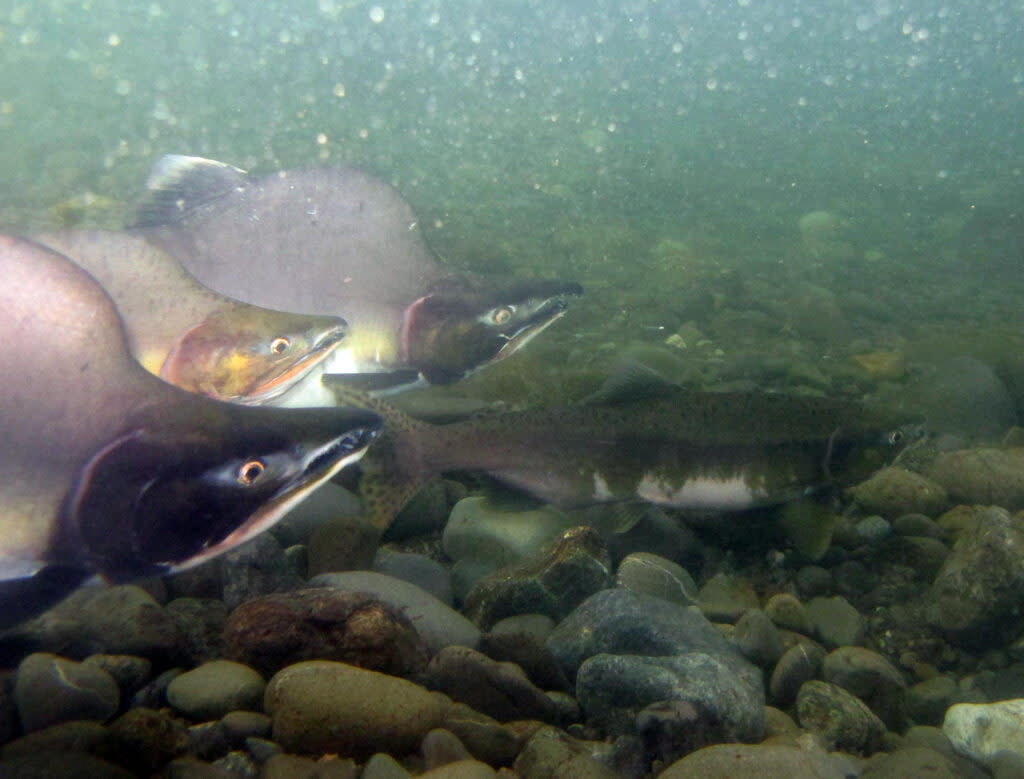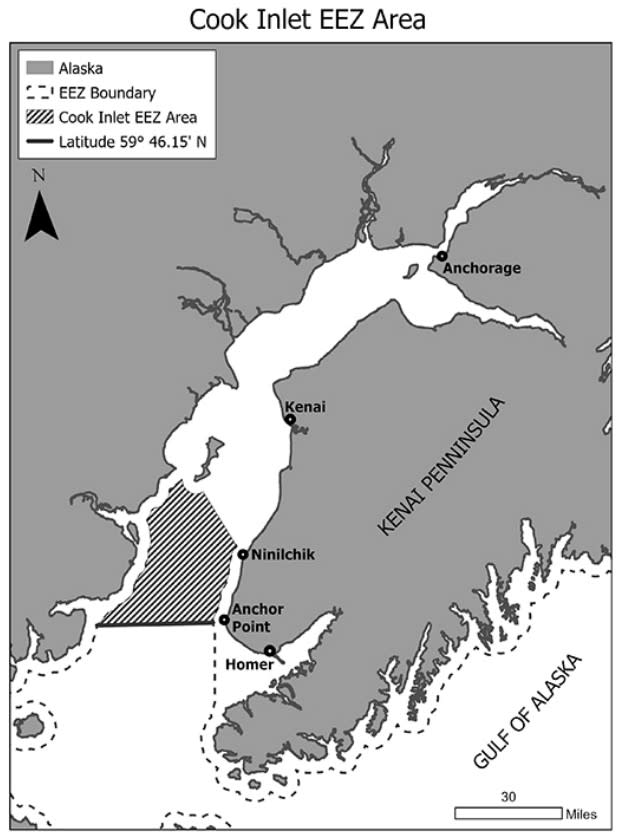The federal government is assuming management of salmon fishing in parts of Alaska’s Cook Inlet

Three male pink salmon pursue a female up Ship Creek in Anchorage on Aug. 9, 2013. Salmon that spawn in Ship Creek are among the many stocks that swim in Cook Inlet. Starting this year, the federal government will be managing salmon fishing in the inlet's federal waters, a break from the decades-long Alaska Department of Fish and Game management of salmon throughout the inlet. (Photo by Katrina Mueller/U.S. FIsh and Wildlife Service)
Commercial and recreational salmon fishing in the federal waters of Cook Inlet will resume this summer, but under new management by the federal government, according to a rule made final this week.
The National Oceanic and Atmospheric Administration’s National Marine Fisheries Service, also known as NOAA Fisheries, is taking over what had been state management of salmon in inlet waters designated as the federal exclusive economic zone, located more than 3 miles offshore.
The new rule goes into effect on May 30.
Until now, the state had managed salmon fisheries in both state and federal waters of the inlet. But the switch in management was ordered by federal courts, as a result of litigation stretching back a decade.
The United Cook Inlet Drift Association, or UCIDA, which is made up of commercial salmon fishers, sued the federal government in 2013 for failing to develop a salmon harvest management plan for the federal waters of the inlet. NMFS, rather than developing a Cook Inlet salmon plan, had deferred to the Alaska Department of Fish and Game, which since statehood has managed salmon harvests throughout the inlet in both state and federal waters.
The UCIDA lawsuit took issue with state management decisions and argued that NMFS was failing in its duties. The 9th U.S. Circuit Court of Appeals ruled in 2016 in UCIDA’s favor.
A subsequent effort through the North Pacific Fishery Management Council to close federal waters to salmon fishing entirely while a new management system was being organized drew another UCIDA lawsuit, in 2021. The federal waters remained open to fishing under state management, albeit temporarily.
Under the new rule, fishers who harvest salmon from federal waters, as well as processors and buyers to which that salmon is delivered, must have new federal permits. The new rule forbids fishers from harvesting in federal and state waters on the same day. It bars deployment of multiple nets and requires additional documentation of catches, among other requirements.

A map shows the federally controlled exclusive economic zone in Cook Inlet, the area of the inlet where the federal government is now managing salmon fishing after decades of state management across all of Cook Inlet. (Map provided by National Oceanic and Atmospheric Administration/National Marine Fisheries Service)
The agency has scheduled two public meetings to explain the new rule, one in Kenai on May 15 and the other in Homer on May 16. Additionally, a webinar is scheduled for May 22.
The fragmented Cook Inlet salmon management that resulted from the litigation has raised concerns among numerous parties, including some federal authorities.
The North Pacific Fishery Management Council, when faced at its April meeting with a choice between possible management alternatives for salmon in Cook Inlet’s federal waters, opted for none of them. Council members said the system they use to manage commercial catches of fish in the ocean, like pollock and cod, is vastly different from what would be needed to properly manage salmon, and that the federal agencies are not equipped to do the precise, flexible, and location-specific in-season salmon management that the state practices.
The Alaska Department of Fish and Game, which rejected an option to co-manage with the federal government, also objected to the way the federal system is set to operate. Setting allowable season catches based on preseason forecasts, as is done with ocean fish like pollock, is a poor fit for salmon, said a letter sent in December to NMFS from Doug Vincent-Lang, the department’s commissioner.
“In short, the proposed Federal program utilizes tools not developed for salmon management, abandons long-standing management practices of the State for conservation and allocation purposes and places the burden of conservation entirely on the State if pre-season catch limits are over-forecasted,” Vincent-Lang’s letter said.
One bright spot of federal management may be a new opportunity for Indigenous harvests, said Gary Harrison, chairman of the Chickaloon Village Traditional Council.
Federal management of salmon in the Cook Inlet federal waters “provides a long overdue opportunity for a Tribal fishery ahead of all other users,” he said in written comments submitted to the North Pacific Fishery Management Council for its April meeting. But Harrison also found fault with the pending federal management plan for Cook Inlet salmon, saying its reliance on past run histories and its absence of systems for precise adjustments during the season would result in management that is “not precautionary.”
Even NMFS, in Tuesday’s Federal Register notice announcing the final rule, acknowledged that it will contend with uncertainties in its Cook Inlet salmon management. The agency, the notice said, “recognizes the complex and challenging nature of Cook Inlet salmon fisheries.”
GET THE MORNING HEADLINES DELIVERED TO YOUR INBOX
The post The federal government is assuming management of salmon fishing in parts of Alaska’s Cook Inlet appeared first on Alaska Beacon.

